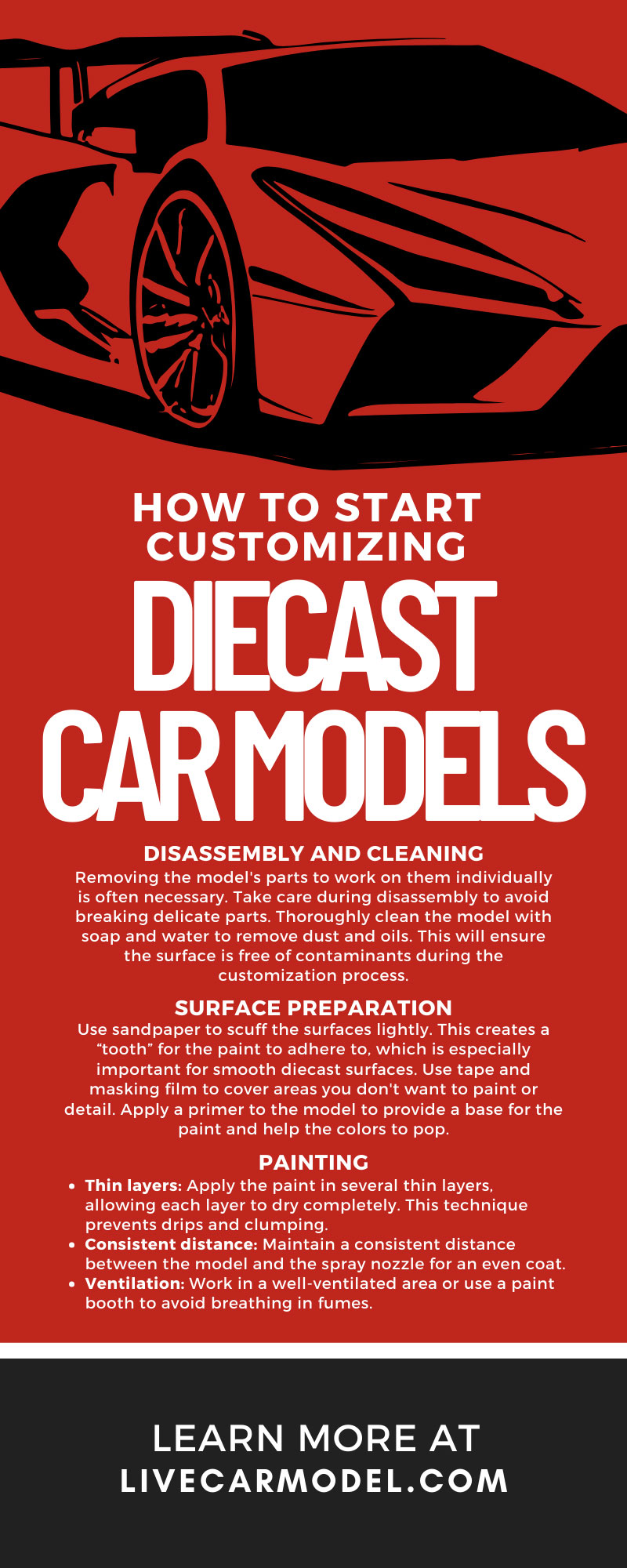The art of collecting and customizing diecast car models is a passion shared by hobbyists and enthusiasts around the world. Initially, diecast cars were replicas of real-life vehicles, but over time, the practice of customizing these models has given rise to a subculture within the diecast car collecting community. Whether you're captivated by classic cars, modern motorsports, or just love showing your unique flair, customizing diecasts can be an incredibly rewarding hobby. This guide will show you how to start customizing your diecast model cars, from getting the right tools to showcasing your masterpieces.
A Brief History of Diecast Cars
Diecast cars have been popular collectibles for many decades. The term 'diecast' refers to the process of melting metal and injecting it into a mold, which gives these miniaturized models their solid, weighty feel. Originally focused on scale accuracy and detailing, diecast cars have now taken a creative turn with the advent of customization. Diecast customizers paint, detail, and even engineer their models to personal specifications, representing a high point of individuality in a mass-produced world.
Exploring the Trend of Diecast Customization
While the hobby of diecast collecting has been popular for ages, the customization trend has only recently exploded because of the rise of social media and online communities, where enthusiasts can share their work and techniques. This has led to a boom in consumer interest, driving the popularity of brands from Ferrari to McLaren model cars to new heights. With this guide, you'll gain insights into the fascinating realm of model car customization, from the first stroke of paint on a diecast body to organizing your display at a car show.
Getting Started: Tools and Materials
Before you can start customizing, you'll need the right equipment. Here's a list of essential tools that every diecast customizer should have in their arsenal:
- Model car: Start with a diecast model you're willing to modify.
- Craft knife: This tool is ideal for precision cutting during modifications and detailing.
- Sanding tools: Sandpaper and sanding sticks will be your best friends when removing casting lines or preparing surfaces for paint.
- Tweezers and pliers: Small parts require a steady hand and the right tools for detachment and reattachment.
- Drill and bits: For more extensive modifications, a drill is necessary to create holes for custom parts or reposition existing ones.
- Paints and primers: High-quality model-grade paints and primers are key to achieving vibrant colors and a smooth finish.
- Brushes and airbrush: The choice between the two depends on the detail level and coverage you want to achieve.
- Topcoat and sealants: Protect your paint job and add a glossy or matte finish with clear coats and sealants.
- Decal setting solutions: These solutions allow decals to seamlessly adhere to the model's surface.
These are just the basics. As you progress, you may find new tools to further your craft.
Preparing for Customization
To prepare for customization, you must ensure you've got everything set up. Carefully select the diecast car you wish to customize. Beginners may want to start with a less complex model to practice techniques. Once you have your base model, it's time to get started.
Disassembly and Cleaning
Removing the model's parts to work on them individually is often necessary. Take care during disassembly to avoid breaking delicate parts. Thoroughly clean the model with soap and water to remove dust and oils. This will ensure the surface is free of contaminants during the customization process.
Surface Preparation
Use sandpaper to scuff the surfaces lightly. This creates a “tooth” for the paint to adhere to, which is especially important for smooth diecast surfaces. Use tape and masking film to cover areas you don't want to paint or detail. Apply a primer to the model to provide a base for the paint and help the colors to pop.
Techniques for Customization
Customizing a diecast model involves several key techniques. Here's how to bring out the best in your creations:
Painting
Painting is one of the most impactful ways to customize a diecast model. Understanding a few best practices will help you achieve a professional finish.
- Thin layers: Apply the paint in several thin layers, allowing each layer to dry completely. This technique prevents drips and clumping.
- Consistent distance: Maintain a consistent distance between the model and the spray nozzle for an even coat.
- Ventilation: Work in a well-ventilated area or use a paint booth to avoid breathing in fumes.
Decal Application
Decals are the details that make a model unique. Apply them with a decal-setting solution for a smooth and professional look.
- Positioning: Use a pair of tweezers to place the decals on the model precisely.
- Setting: Apply decal setting solution to soften the decals' edges and help them conform to the model's shape.
Detailing
Detailing can be as subtle as adding a pinstripe or as complex as replicating an engine's wiring harness.
- Fine brushes: Use small, pointed brushes for fine details.
- Patience: Take your time with each detail to ensure accuracy and neatness.
Cleaning and Maintaining Your Diecast Model Cars
After customizing, it's essential to clean and maintain your models properly to keep them looking their best. Always handle the model by the base or any sturdy, non-painted parts to prevent smudges or scratches. Regularly dust your models with a soft brush and clean themcusing a mild, soapy water solution, but never soak the model or use harsh cleaners. Avoid direct sunlight since prolonged exposure can fade paint and damage plastic parts over time.
Showcasing Your Custom Work
Now that you've transformed your diecast model with custom paint and details, it's time to show it off. Here are a few things to keep in mind:
- Display Cases: Choose a display case that not only protects your model but also complements your customizations.
- Lighting: Good lighting can bring out the best in your model, so place it in a well-lit area or use spotlights to highlight specific details.
- Photography: Learn basic photography skills to capture the essence of your model. Using a tripod and a backdrop can lead to professional-quality pictures.
With these ideas in mind, you can show off your collection to other enthusiasts.
Building Your Collection and Network
Networking with other diecast enthusiasts is a great way to share experiences and learn new techniques. Attend model car shows and join online communities to connect with others who share your passion. Engage with hobbyist groups on social media or forums, attend diecast events, and consider starting your own club or meetup. Look for local hobby shops, swap meets, and online auctions to find the next models you envision to customize.
A Journey as Endless as Your Creativity
The world of diecast car customization is as endless as your creativity. By learning how to start customizing diecast car models, you can get in on the action, too. The satisfaction of watching your work evolve from a factory model to a unique creation is unparalleled. Share your experience with others and inspire them to start their own diecast journeys.


